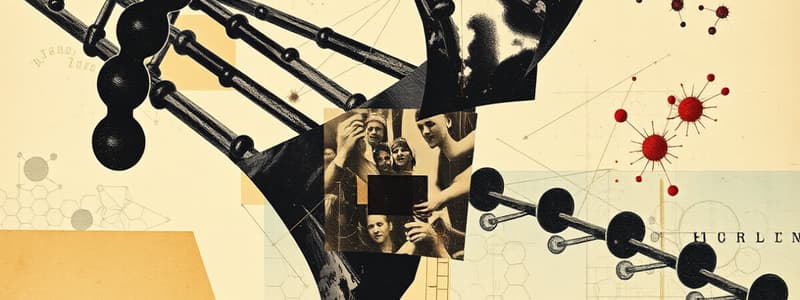Podcast
Questions and Answers
What best describes the structure of DNA?
What best describes the structure of DNA?
A double helix consisting of two sugar-phosphate backbones with nucleobases oriented towards the interior.
How do nucleobases pair and bond in DNA?
How do nucleobases pair and bond in DNA?
Adenine pairs with thymine via two hydrogen bonds; cytosine pairs with guanine via three hydrogen bonds.
Doubled-stranded DNA consists of two antiparallel strands.
Doubled-stranded DNA consists of two antiparallel strands.
True (A)
What is the smallest unit of an element that retains all properties of that element?
What is the smallest unit of an element that retains all properties of that element?
What are the six most common elements found in all living organisms?
What are the six most common elements found in all living organisms?
How can atoms become more stable or less reactive?
How can atoms become more stable or less reactive?
Match the following definitions to the terms:
Match the following definitions to the terms:
Match the description with the name of the chemical bond.
Match the description with the name of the chemical bond.
What type of bond holds together adjacent amino acids in a protein?
What type of bond holds together adjacent amino acids in a protein?
What level of protein structure do alpha helices and beta-pleated sheets represent?
What level of protein structure do alpha helices and beta-pleated sheets represent?
What defines the hydrogen ion concentration of a solution?
What defines the hydrogen ion concentration of a solution?
In a solution of seawater, the ______ is the solvent, while the ______ is the solute.
In a solution of seawater, the ______ is the solvent, while the ______ is the solute.
What would happen if a single bacterial cell were treated with a poison that inhibited all enzymes?
What would happen if a single bacterial cell were treated with a poison that inhibited all enzymes?
Which of the following statements regarding enzymes is true? (Select all that apply)
Which of the following statements regarding enzymes is true? (Select all that apply)
Flashcards are hidden until you start studying
Study Notes
Structure of DNA
- DNA is a double helix with two sugar-phosphate backbones and nucleobases positioned inward.
- Adenine (A) pairs with Thymine (T) via two hydrogen bonds; Cytosine (C) pairs with Guanine (G) via three hydrogen bonds.
- DNA consists of two antiparallel strands: one in the 5' to 3' direction and the other in the 3' to 5' direction.
Basic Units of Matter
- An atom is the smallest unit of an element that retains its properties.
- The six most common elements in living organisms are carbon, hydrogen, nitrogen, oxygen, phosphorus, and sulfur.
- Atoms are composed of negatively charged electrons, positively charged protons, and uncharged neutrons.
Atomic Stability and Bonding
- Atoms achieve stability by losing or gaining electrons for a full outer shell or by sharing electrons with other atoms.
- Chemical bonds include:
- Ionic Bonds: Attraction between positively and negatively charged ions through electron transfer.
- Covalent Bonds: Formation through shared electrons between two atoms.
- Hydrogen Bonds: Weak attractions between a positively charged hydrogen atom and a negatively charged atom.
Properties of Water
- Water is a polar molecule and forms hydrogen bonds, serving as an effective solvent for charged solutes.
- In seawater, water is the solvent and salt is the solute.
- Olive oil is least likely to dissolve in water due to its nonpolar nature.
pH and Buffers
- pH is defined by hydrogen ion concentration; as hydrogen ions increase, pH decreases.
- Buffers help maintain relatively constant pH by releasing or binding protons when acids or bases are added.
Carbohydrates
- Types of carbohydrates:
- Monosaccharide: Fructose
- Disaccharide: Lactose
- Polysaccharides: Cellulose, Starch, Glycogen, Chitin
- Important sources for energy: Glucose is commonly broken down in cells.
Proteins Structure
- Adjacent amino acids in proteins are linked by peptide bonds, crucial for maintaining primary structure.
- Secondary protein structures include alpha helices and beta-pleated sheets, characterized by specific folding patterns.
- Tertiary structure is stabilized by disulfide bonds.
Nucleic Acids
- Components of DNA and RNA include amino acids, phosphate groups, nucleobases, and deoxyribose.
- RNA contains nucleobases adenine (A), uracil (U), guanine (G), and cytosine (C).
Chemical Calculations
- Carbon has 4 valence electrons, necessitating 4 additional electrons to complete its outer shell for stability.
Biological Implications of Chemical Properties
- If a bacterial cell lacks buffers, pH fluctuations could disrupt enzyme function and molecular activities, potentially leading to cell death.
Studying That Suits You
Use AI to generate personalized quizzes and flashcards to suit your learning preferences.




